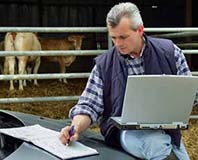Read the latest information on
Foot-and-mouth disease
 A big part of any on-farm biosecurity plan is managing the introduction of new livestock to the property. As with all farm inputs, new animals can bring in weed seeds, insect pests, disease agents and other parasites, any of which can have a big impact on your property.
A big part of any on-farm biosecurity plan is managing the introduction of new livestock to the property. As with all farm inputs, new animals can bring in weed seeds, insect pests, disease agents and other parasites, any of which can have a big impact on your property.
You can manage these risks in a number of ways, such as isolating new stock for around three weeks to ensure they shed weed seeds, can be treated and are free of parasites, and give them time to show symptoms of disease, according to Dr Simon Humphrys, Executive Manager Biosecurity and Product Integrity Services at Animal Health Australia.
“Isolating new stock means that any incursions will be isolated to one area of the property and cannot spread to other areas of a farm or existing livestock,” said Dr Humphrys.
“But it’s important to remember that this is responding to the threat, rather than always eliminating it.”
For a higher level of assurance, producers can ask for an Animal Health Declaration in order to capture vital information about the health status (eg paraciticide treatment, vaccinations) of new animals prior to purchase or arrival.
Producers bringing in new livestock should always request an Animal Health Declaration in order to capture information about the origin and previous medical history – including any treatments or vaccinations – of the animals they are buying.
“This means they can make an informed decision about the risks associated with those animals and manage their introduction accordingly,” said Dr Humphrys.
“Knowing what you may be up against is the first step in putting together a management plan.”
Animal Health Declarations are generally used in producer-to-producer transfers, though at times they may be needed when sending animals to a saleyard.
“The Declaration is made from one producer to another, creating a sort of hand-over document for the animals concerned,” said Dr Humphrys.
“This is important for producers actively managing certain conditions or looking for a high level of assurance that the animals are healthy. It’s less likely to be a factor when sending animals for slaughter – that would be covered under the National Vendor Declaration.”
Declarations should be filled out honestly and to the best of the seller’s knowledge. In some cases, such as where the seller has not owned the animals since birth, it may be difficult to provide some information – that’s okay!
“It’s best to provide as much information to your buyer as you can,” said Dr Humphrys.
“This information helps them to be as prepared as possible to receive those animals.”
For more information on managing farm inputs, or to download the latest Animal Health Declarations, visit the Farm Biosecurity Farm Inputs page.